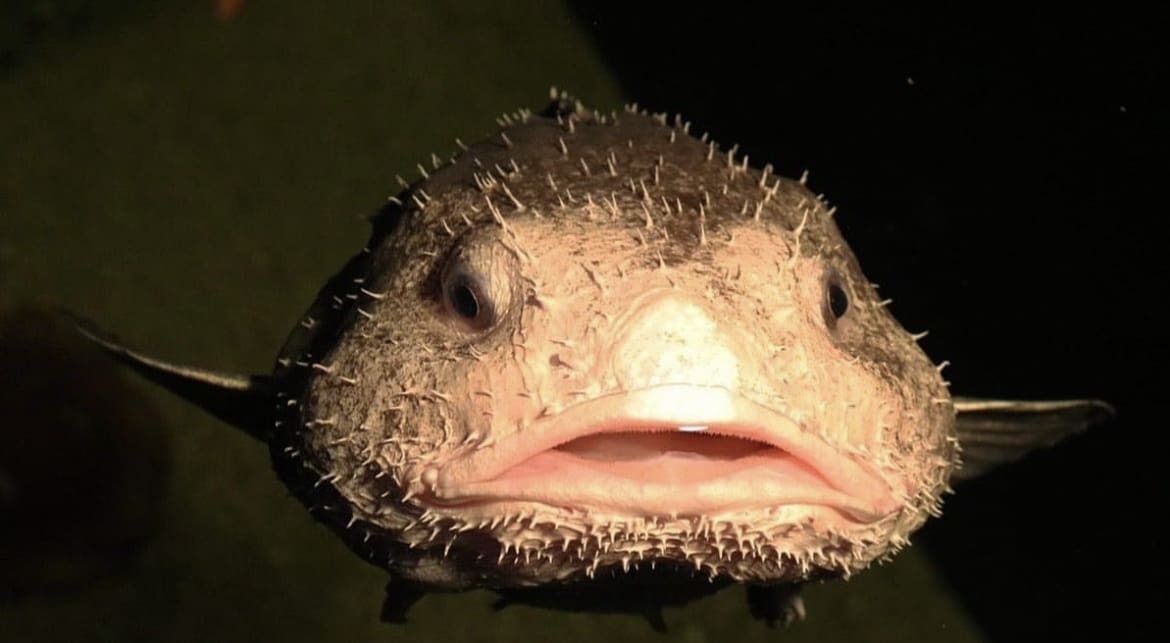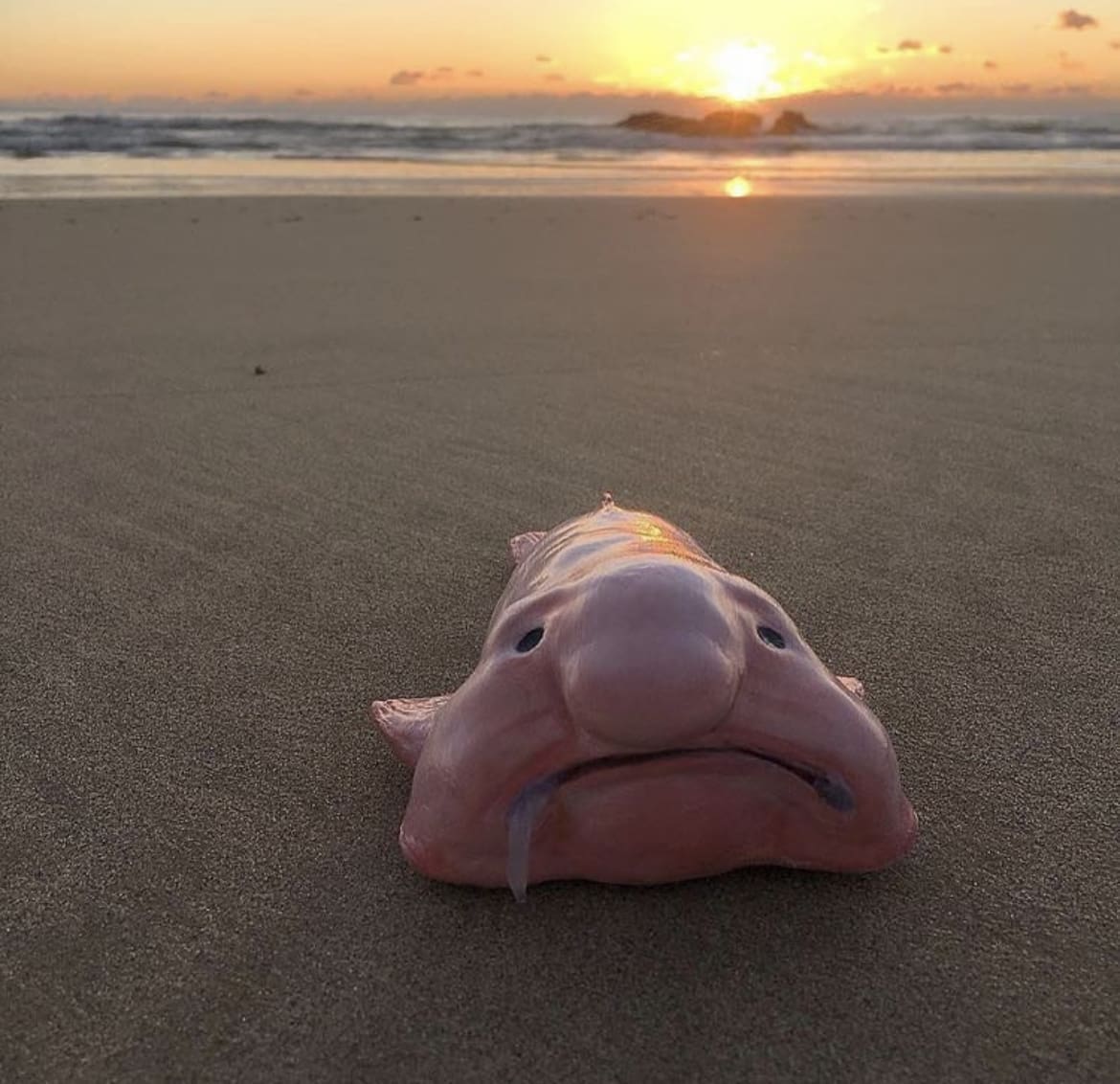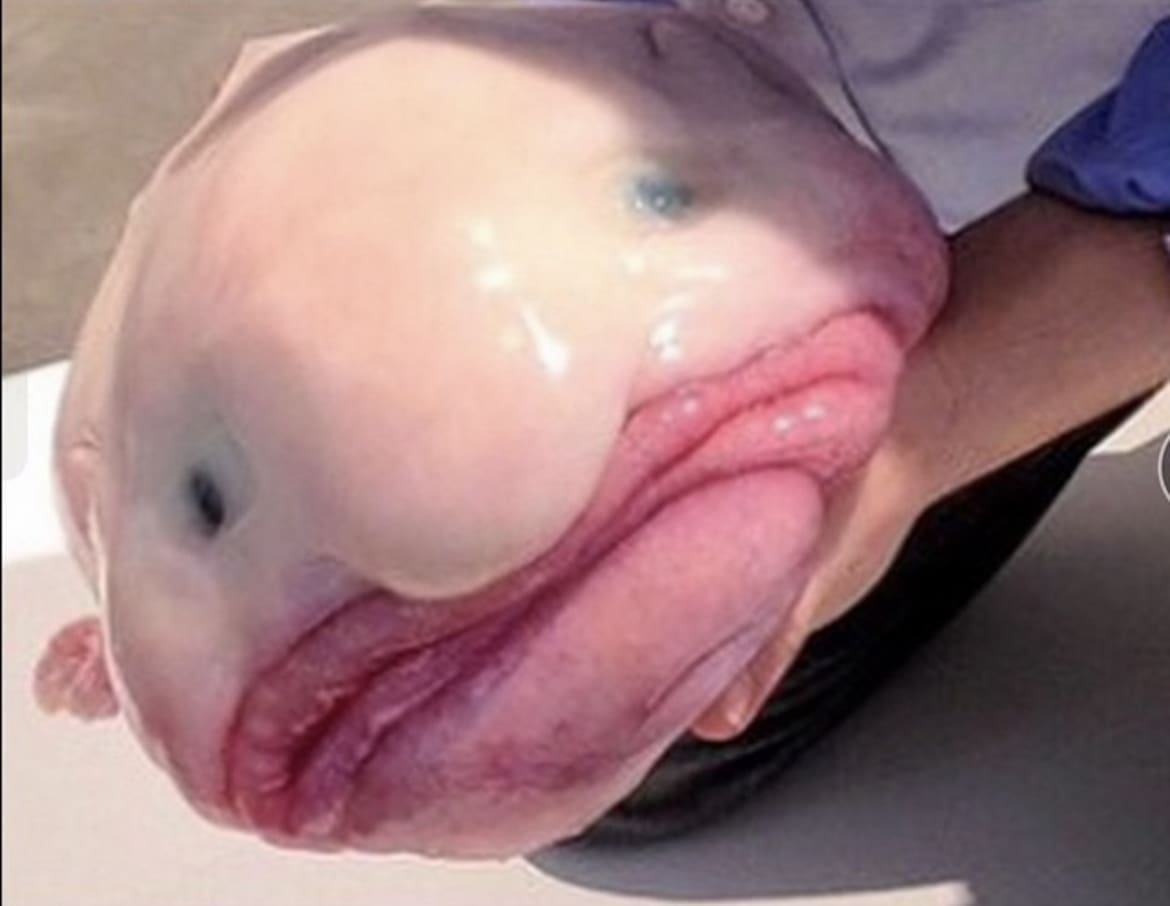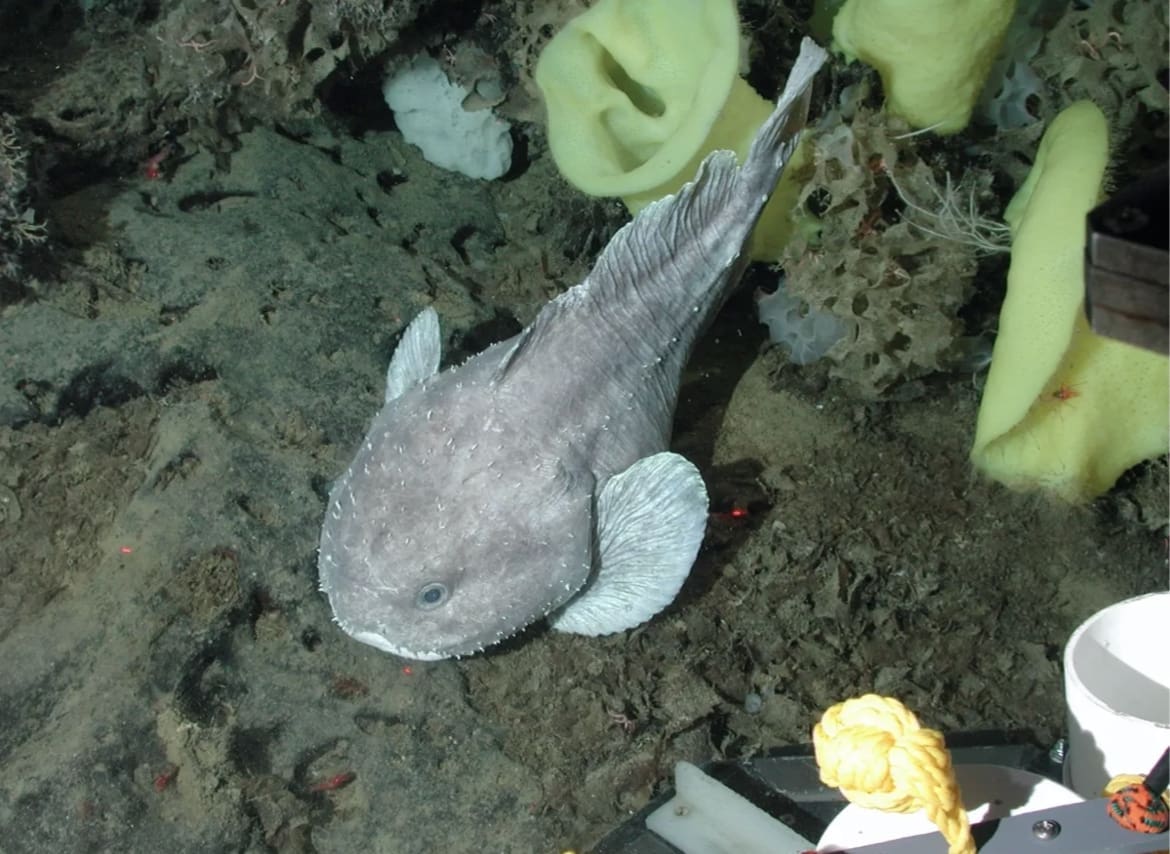[social_warfare]
So, you’ve probably seen this face only a mother could love plastered across memes and “ugliest animal” polls, right? Meet the blob fish, or Psychrolutes marcidus if you want to get all scientific about it. This gelatinous wonder isn’t just a fixture of internet fame; it’s a bona fide inhabitant of the deep sea, living life at pressures that would squish the rest of us into a human pancake.
So What is the Blob Fish, Anyway?
Residing at depths of 600 to 1,200 meters where the pressure is an insane 60 to 120 times greater than at sea level, this fish has adapted to an environment that’s about as forgiving as a landlord on rent day.
Why the buzz, though? Well, the blob fish breaks the mold of your typical Nemo or Dory. It’s not about flashy colors or sleek swimming; it’s about survival in the deep blue’s equivalent of outer space. This creature is a testament to the weird, the adaptive, and the outright miraculous nature of evolution. So, buckle up as we dive deep (pun intended) into the world of the blob fish, a creature that challenges our perceptions of beauty and resilience in the animal kingdom.
What Do Blob Fish Look Like?
Imagine if a fish decided to go as a puddle for Halloween—that’s your blob fish. Out of water, it’s got this droopy, sad sack appearance that’s spawned a thousand memes. But don’t let its deflated balloon look fool you; in its natural habitat, the blob fish leads a far less comical existence.
With a body density slightly less than water, the blob fish is a master of the effortless float. No need for a swim bladder here; its gelatinous body allows it to hover just above the seafloor, waiting to ambush unsuspecting prey. This almost gravity-defying act is the blob fish’s secret weapon, letting it conserve energy in an environment where every calorie counts.
Size-wise, they’re not about to win any heavyweight titles. Typically, blob fish are about as long as a ruler, with some variation here and there. Their appearance, often described as a mix between a grumpy old man and a glob of goo, belies a creature perfectly adapted to life under extreme pressure.
How Big Are Blob Fish?
So, how big does this gloopy ambassador of the deep get? On average, blob fish are around 30 centimeters (about 12 inches) long. But, like any good fish tale, sizes can vary. Think of them as the underwater equivalent of a medium-sized lapdog—only, you know, less cuddly and a bit more on the squishy side.
Their size is pretty much perfect for the life they lead. Big enough to gulp down whatever unfortunate sea critters happen to drift their way, but not so large as to make life under extreme pressure untenable. It’s all about that sweet spot, and the blob fish has found its niche in a place most other creatures would find inhospitable.
Blob Fish Skin: Not Your Average Fish Scale
When you’re living under the kind of pressure that would turn other fish into fish sticks, you’ve got to have skin that can handle it. The blob fish’s skin is a marvel of deep-sea adaptation. It’s not about winning beauty contests; it’s about survival. This fish’s skin is thick, gooey, and gelatinous, providing just the right amount of resistance against the crushing depths. No scales here—just a smooth, jelly-like texture that would probably make for the world’s worst facial.
This squishy exterior plays a critical role in the blob fish’s life. It’s density is just right, allowing the fish to float above the sea floor without wasting energy on swimming. Think of it as nature’s way of giving the blob fish a perpetual hover mode. Plus, it’s incredibly efficient. No need for a fancy swim bladder; the blob fish’s own body composition keeps it buoyant. In a place where efficiency is key, the blob fish’s skin is its ticket to an easy ride.
Blob Fish Teeth
Now, before you start imagining the blob fish with a shark-like grin, let’s set the record straight: if the blob fish had a dental plan, it’d be pretty minimal. Its mouth is more about gulping than chewing, equipped to swallow marine snow (organic material that falls from higher in the water column) and small critters whole.
The blob fish’s diet is a low-effort affair, fitting for a creature that looks like it can’t be bothered. It’s not out chasing down meals; instead, it waits for the buffet to come to it. The design of its mouth and the near-absence of teeth reflect this laid-back dining style. So, no, it’s not going to bite—unless you’re a tiny sea creature that happens to float by.
Blob Fish Eyes
Given its underwhelming dental situation, you might wonder if the blob fish has better luck in the vision department. Living in the deep, dark depths of the ocean, you’d think evolution would hook it up with some night-vision goggles or something. Well, the blob fish’s eyes are small and not particularly well-adapted for seeing in the dark, murky waters it calls home.
This might seem like a raw deal, but remember, the blob fish doesn’t need to dodge predators or chase down speedy prey. Its lifestyle is more about sitting tight and waiting for food to come to it. The blob fish’s eyes are good enough for detecting the faint silhouettes of food floating by, and in the deep sea, that’s all you really need. It’s a world where energy conservation is key, and every adaptation, no matter how seemingly underwhelming, serves a purpose.
Blob Fish Coloration
When it comes to fashion, the blob fish isn’t winning any awards, but in the high-pressure world of the deep sea, its coloration is all about functionality. Sporting a nondescript, muted palette that ranges from a dusky pink to a drab grey, the blob fish’s coloration is the perfect camouflage for the deep blue. This isn’t the bright, coral reef part of the ocean; it’s the murky, no-light zone where blending in means staying alive.
This subtle coloration helps the blob fish avoid becoming an easy target for the few predators that roam its deep-sea neighborhood. Plus, without any natural light, flashy colors wouldn’t be seen anyway. The blob fish’s look is perfectly adapted to its environment, ensuring it stays under the radar, both literally and figuratively.
What Do Blob Fish Eat?
You might expect the diet of the blob fish to be as bizarre as its appearance, but it’s surprisingly mundane. Primarily, blob fish are opportunistic feeders, dining on whatever edible bits drift down to their level. This can include small crustaceans, sea pens, and other slow-moving or stationary deep-sea snacks. The blob fish’s eating strategy is the ultimate in energy conservation. Why swim after your food when you can just open your mouth and wait for dinner to float in?
The blob fish’s diet reflects its overall strategy: minimal effort for maximum gain. It’s not picky; when you live where it does, you can’t afford to be. Every meal is about making the most of what the deep sea provides, utilizing a lifestyle that conserves as much energy as possible. In the blob fish’s world, it’s not about the thrill of the hunt; it’s about the wait for the drift.
Blob Fish Social Structure
If you’re picturing a social network of blob fishes hanging out and sharing the latest sea gossip, you might be a bit disappointed. Blob fishes are largely solitary creatures, rarely interacting with others of their kind. Their social structure, if you can call it that, is more about solitary survival than forming bonds or communities.
This doesn’t mean blob fishes are complete loners by choice. Their sparse population and the vastness of their deep-sea environment make encounters with other blob fishes rare. When they do meet, it’s usually by chance, and there’s little to no interaction. They don’t form schools or pairs; each blob fish is an independent unit, drifting through the deep sea and living a life of quiet solitude.
The lack of social structure among blob fishes is yet another adaptation to their environment. In the deep sea, resources are scarce, and competition is minimal. There’s no need for complex social behaviors when you spend your days floating alone, waiting for food to come your way. For the blob fish, solitude is not just a way of life; it’s the key to survival in one of the most inhospitable places on Earth.
How Do Blob Fish Reproduce?
Diving into the love life of the blob fish, you might be surprised to find it’s not as gloomy as their expression suggests. When it comes to reproduction, blob fishes maintain their low-energy ethos, but they do get the job done. The details are a bit murky—after all, observing blob fish in the wild, especially during intimate moments, is a challenge. However, it’s believed that like many deep-sea creatures, blob fishes employ external fertilization, where females release eggs into the water to be fertilized by males.
This method fits perfectly with their laid-back lifestyle. There’s no need for elaborate mating dances or long courtships in the deep sea. Instead, it’s about maximizing the chance of success with minimal effort. The females lay eggs on the ocean floor, often under rocks or in other protected areas, and the males fertilize them as they pass by. Once the deed is done, blob fish parents go their separate ways, leaving the eggs to develop and hatch on their own.
How Long Do Blob Fish Live?
Estimating the lifespan of a creature as elusive as the blob fish is tricky, but they’re believed to have relatively long lives for fish, potentially living for several decades. This extended lifespan is likely a result of their slow-paced lifestyle and the stable, albeit harsh, conditions of the deep sea.
The blob fish’s longevity is another testament to its efficiency. In an environment where every movement and every calorie counts, growing slowly and living long is a strategy that makes sense. It allows them to reproduce over a longer period and increases their chances of survival in the deep sea’s vast and sparsely populated expanses.
Is the Blob Fish Dangerous?
Let’s face it, the blob fish looks like it couldn’t chase you down even if it wanted to. And you’d be right to think so. Blob fishes pose no danger to humans—mostly because they’re deep-sea dwellers and our paths rarely cross. But even in their own domain, blob fishes are harmless. They’re not predators in the traditional sense; they’re scavengers and opportunistic feeders, living off what the ocean currents bring their way.
The idea of the blob fish being dangerous is a bit of a humorous notion. With their slow movements, gelatinous bodies, and passive feeding habits, they’re about as threatening as a bowl of Jell-O. The only risk they pose is to the tiny invertebrates that drift into their path. For the rest of the ocean—and for us humans—the blob fish is simply a fascinating example of nature’s adaptability, not a creature to be feared.
Are Blob Fish Territorial?
Given their solitary and passive nature, you might wonder if blob fish have any territorial instincts. In the vast and empty expanses of the deep sea, the concept of territory is a bit different from what you’d find in more populated waters. Blob fish do not exhibit territorial behavior in the traditional sense; they don’t guard specific patches of ocean floor or chase away intruders. Their survival strategy does not rely on defending a particular area but rather on being able to exist wherever there’s enough deep-sea detritus and small creatures to consume.
This lack of territorial aggression further underscores the blob fish’s energy-conservation lifestyle. In an environment where encounters with others of their kind are rare, and the effort required to actively defend a territory would far outweigh the benefits, the blob fish opts for a more nomadic existence, drifting wherever the currents and food supply take them.
Can Blob Fish Swim?
The image of the blob fish lazily floating in the deep might lead some to question its swimming abilities. Indeed, blob fish are not strong swimmers. Their bodies are designed more for buoyancy and drifting than for active, agile movement. The blob fish relies on its gelatinous body, which is slightly less dense than the surrounding water, to maintain its position in the water column with minimal effort.
Instead of swimming through the water like many fish, blob fish are more likely to use subtle movements to navigate their deep-sea environment. These movements are so minimal they might not even be considered swimming in a traditional sense. This adaptation is perfect for the energy-scarce deep sea, where conserving calories is crucial for survival.
How Fast Are Blob Fish?
Given their lack of swimming prowess, it’s probably no surprise that speed is not in the blob fish’s repertoire. You won’t find blob fish participating in any underwater races; they’re among the slowest-moving creatures in the ocean. Their mode of transportation is more about gentle drifting than speed, perfectly suited to their low-energy lifestyle and the environment they inhabit.
The blob fish’s lack of speed is yet another adaptation to the high-pressure, low-energy world of the deep sea. In a place where fast movements and high speeds would require more energy than the environment can provide, the blob fish’s slow, drifting way of life ensures it conserves every possible bit of energy, optimizing its chances of survival in the deep.
Are Blob Fish Territorial?
Given their solitary and passive nature, you might wonder if blob fish have any territorial instincts. In the vast and empty expanses of the deep sea, the concept of territory is a bit different from what you’d find in more populated waters. Blob fish do not exhibit territorial behavior in the traditional sense; they don’t guard specific patches of ocean floor or chase away intruders. Their survival strategy does not rely on defending a particular area but rather on being able to exist wherever there’s enough deep-sea detritus and small creatures to consume.
This lack of territorial aggression further underscores the blob fish’s energy-conservation lifestyle. In an environment where encounters with others of their kind are rare, and the effort required to actively defend a territory would far outweigh the benefits, the blob fish opts for a more nomadic existence, drifting wherever the currents and food supply take them.
Can Blob Fish Swim?
The image of the blob fish lazily floating in the deep might lead some to question its swimming abilities. Indeed, blob fish are not strong swimmers. Their bodies are designed more for buoyancy and drifting than for active, agile movement. The blob fish relies on its gelatinous body, which is slightly less dense than the surrounding water, to maintain its position in the water column with minimal effort.
Instead of swimming through the water like many fish, blob fish are more likely to use subtle movements to navigate their deep-sea environment. These movements are so minimal they might not even be considered swimming in a traditional sense. This adaptation is perfect for the energy-scarce deep sea, where conserving calories is crucial for survival.
How Fast Are Blob Fish?
Given their lack of swimming prowess, it’s probably no surprise that speed is not in the blob fish’s repertoire. You won’t find blob fish participating in any underwater races; they’re among the slowest-moving creatures in the ocean. Their mode of transportation is more about gentle drifting than speed, perfectly suited to their low-energy lifestyle and the environment they inhabit.
The blob fish’s lack of speed is yet another adaptation to the high-pressure, low-energy world of the deep sea. In a place where fast movements and high speeds would require more energy than the environment can provide, the blob fish’s slow, drifting way of life ensures it conserves every possible bit of energy, optimizing its chances of survival in the deep.
Threats to Blob Fish in the Wild
The blob fish faces several threats, many of which stem from human activities. Despite its deep-sea habitat, it’s not immune to the impacts of fishing, particularly bottom trawling, which disrupts the seabed environment. This form of fishing can destroy the delicate balance of the blob fish’s ecosystem, affecting its food sources and directly endangering its population. Additionally, climate change poses a less direct but equally concerning threat, potentially altering the deep-sea environment in ways that could affect the blob fish and its neighbors.
The challenge in protecting the blob fish lies in the complexity of its habitat. The deep sea is a difficult place to study and even harder to manage for conservation. Efforts to mitigate these threats require international cooperation and a commitment to sustainable fishing practices and ocean conservation.
Where to See Blob Fish
For those intrigued by the blob fish and wishing to catch a glimpse outside of the digital realm, options are, unfortunately, limited. Their deep-sea habitat makes direct observation virtually impossible for casual enthusiasts. However, some specimens have been brought to the surface and preserved in museums and aquariums. The Australian Museum in Sydney, for example, has a blob fish specimen on display.
These preserved specimens offer a rare opportunity to see the blob fish up close, but they also serve as a reminder of the creature’s vulnerability. Public education and awareness can play a significant role in the conservation of the blob fish and its habitat, making these displays more than just curiosities; they’re a call to action.
Tips for Spotting Blob Fish
For the aspiring blob fish spotters, the reality is that seeing one in its natural habitat is unlikely. However, there are ways to engage with the world of the blob fish and deepen your understanding of this unique creature:
- Visit museums and aquariums that feature deep-sea exhibits.
- Support and follow deep-sea research expeditions online; many share findings and images from their dives.
- Engage with conservation organizations that focus on ocean protection, helping to preserve the habitat of the blob fish and countless other deep-sea creatures.
Facts about The Blob Fish
- The blob fish lives at depths where the pressure is dozens of times higher than at sea level.
- It has a gelatinous body that allows it to float just above the seafloor, conserving energy.
- Despite its somewhat sad appearance out of water, the blob fish is perfectly adapted to its deep-sea environment.
- It is not considered dangerous to humans or other large marine animals.
- The blob fish’s diet consists mainly of small invertebrates that float into its mouth.
Myths about The Blob Fish
- It’s the ugliest fish in the sea: Beauty is in the eye of the beholder, and the blob fish’s appearance is a result of its deep-sea adaptations.
- It can be found all over the world: The blob fish is primarily found in the waters around Australia, Tasmania, and New Zealand.
- It’s always been a popular oddity: The blob fish rose to internet fame relatively recently; before that, it was a little-known creature of the deep.
The blob fish, with its peculiar appearance and deep-sea lifestyle, captivates the imagination and highlights the diversity of life on our planet. It serves as a reminder of the wonders that lie hidden in the depths of the ocean and the importance of preserving these fragile ecosystems. Through understanding and appreciating creatures like the blob fish, we can foster a greater connection to the natural world and a stronger commitment to its protection.






